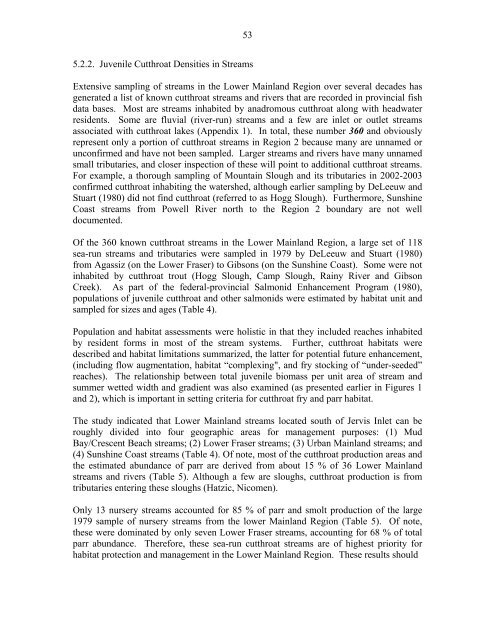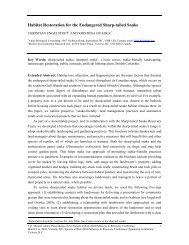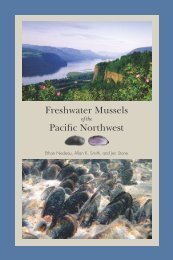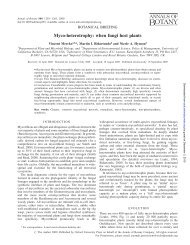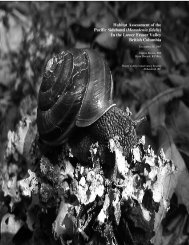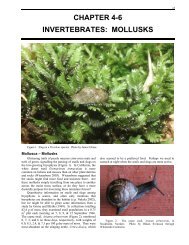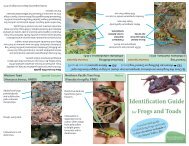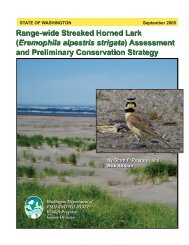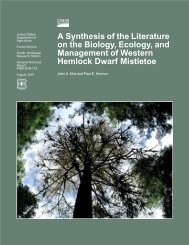Coastal Cutthroat Trout as Sentinels of Lower Mainland Watershed ...
Coastal Cutthroat Trout as Sentinels of Lower Mainland Watershed ...
Coastal Cutthroat Trout as Sentinels of Lower Mainland Watershed ...
You also want an ePaper? Increase the reach of your titles
YUMPU automatically turns print PDFs into web optimized ePapers that Google loves.
535.2.2. Juvenile <strong>Cutthroat</strong> Densities in StreamsExtensive sampling <strong>of</strong> streams in the <strong>Lower</strong> <strong>Mainland</strong> Region over several decades h<strong>as</strong>generated a list <strong>of</strong> known cutthroat streams and rivers that are recorded in provincial fishdata b<strong>as</strong>es. Most are streams inhabited by anadromous cutthroat along with headwaterresidents. Some are fluvial (river-run) streams and a few are inlet or outlet streams<strong>as</strong>sociated with cutthroat lakes (Appendix 1). In total, these number 360 and obviouslyrepresent only a portion <strong>of</strong> cutthroat streams in Region 2 because many are unnamed orunconfirmed and have not been sampled. Larger streams and rivers have many unnamedsmall tributaries, and closer inspection <strong>of</strong> these will point to additional cutthroat streams.For example, a thorough sampling <strong>of</strong> Mountain Slough and its tributaries in 2002-2003confirmed cutthroat inhabiting the watershed, although earlier sampling by DeLeeuw andStuart (1980) did not find cutthroat (referred to <strong>as</strong> Hogg Slough). Furthermore, SunshineCo<strong>as</strong>t streams from Powell River north to the Region 2 boundary are not welldocumented.Of the 360 known cutthroat streams in the <strong>Lower</strong> <strong>Mainland</strong> Region, a large set <strong>of</strong> 118sea-run streams and tributaries were sampled in 1979 by DeLeeuw and Stuart (1980)from Ag<strong>as</strong>siz (on the <strong>Lower</strong> Fr<strong>as</strong>er) to Gibsons (on the Sunshine Co<strong>as</strong>t). Some were notinhabited by cutthroat trout (Hogg Slough, Camp Slough, Rainy River and GibsonCreek). As part <strong>of</strong> the federal-provincial Salmonid Enhancement Program (1980),populations <strong>of</strong> juvenile cutthroat and other salmonids were estimated by habitat unit andsampled for sizes and ages (Table 4).Population and habitat <strong>as</strong>sessments were holistic in that they included reaches inhabitedby resident forms in most <strong>of</strong> the stream systems. Further, cutthroat habitats weredescribed and habitat limitations summarized, the latter for potential future enhancement,(including flow augmentation, habitat “complexing", and fry stocking <strong>of</strong> “under-seeded”reaches). The relationship between total juvenile biom<strong>as</strong>s per unit area <strong>of</strong> stream andsummer wetted width and gradient w<strong>as</strong> also examined (<strong>as</strong> presented earlier in Figures 1and 2), which is important in setting criteria for cutthroat fry and parr habitat.The study indicated that <strong>Lower</strong> <strong>Mainland</strong> streams located south <strong>of</strong> Jervis Inlet can beroughly divided into four geographic are<strong>as</strong> for management purposes: (1) MudBay/Crescent Beach streams; (2) <strong>Lower</strong> Fr<strong>as</strong>er streams; (3) Urban <strong>Mainland</strong> streams; and(4) Sunshine Co<strong>as</strong>t streams (Table 4). Of note, most <strong>of</strong> the cutthroat production are<strong>as</strong> andthe estimated abundance <strong>of</strong> parr are derived from about 15 % <strong>of</strong> 36 <strong>Lower</strong> <strong>Mainland</strong>streams and rivers (Table 5). Although a few are sloughs, cutthroat production is fromtributaries entering these sloughs (Hatzic, Nicomen).Only 13 nursery streams accounted for 85 % <strong>of</strong> parr and smolt production <strong>of</strong> the large1979 sample <strong>of</strong> nursery streams from the lower <strong>Mainland</strong> Region (Table 5). Of note,these were dominated by only seven <strong>Lower</strong> Fr<strong>as</strong>er streams, accounting for 68 % <strong>of</strong> totalparr abundance. Therefore, these sea-run cutthroat streams are <strong>of</strong> highest priority forhabitat protection and management in the <strong>Lower</strong> <strong>Mainland</strong> Region. These results should


